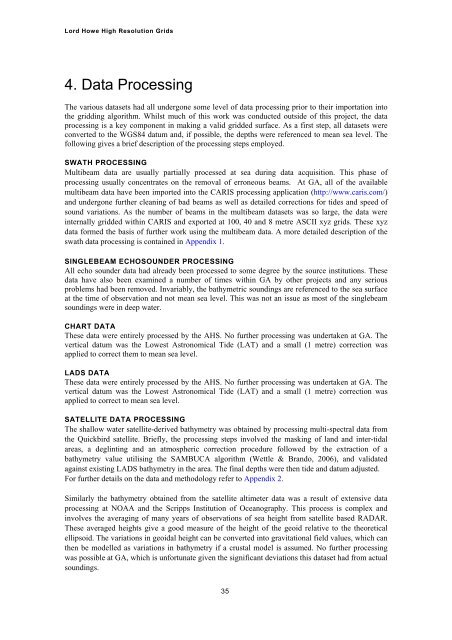Document Title - Geoscience Australia
Document Title - Geoscience Australia
Document Title - Geoscience Australia
Create successful ePaper yourself
Turn your PDF publications into a flip-book with our unique Google optimized e-Paper software.
Lord Howe High Resolution Grids<br />
4. Data Processing<br />
The various datasets had all undergone some level of data processing prior to their importation into<br />
the gridding algorithm. Whilst much of this work was conducted outside of this project, the data<br />
processing is a key component in making a valid gridded surface. As a first step, all datasets were<br />
converted to the WGS84 datum and, if possible, the depths were referenced to mean sea level. The<br />
following gives a brief description of the processing steps employed.<br />
SWATH PROCESSING<br />
Multibeam data are usually partially processed at sea during data acquisition. This phase of<br />
processing usually concentrates on the removal of erroneous beams. At GA, all of the available<br />
multibeam data have been imported into the CARIS processing application (http://www.caris.com/)<br />
and undergone further cleaning of bad beams as well as detailed corrections for tides and speed of<br />
sound variations. As the number of beams in the multibeam datasets was so large, the data were<br />
internally gridded within CARIS and exported at 100, 40 and 8 metre ASCII xyz grids. These xyz<br />
data formed the basis of further work using the multibeam data. A more detailed description of the<br />
swath data processing is contained in Appendix 1.<br />
SINGLEBEAM ECHOSOUNDER PROCESSING<br />
All echo sounder data had already been processed to some degree by the source institutions. These<br />
data have also been examined a number of times within GA by other projects and any serious<br />
problems had been removed. Invariably, the bathymetric soundings are referenced to the sea surface<br />
at the time of observation and not mean sea level. This was not an issue as most of the singlebeam<br />
soundings were in deep water.<br />
CHART DATA<br />
These data were entirely processed by the AHS. No further processing was undertaken at GA. The<br />
vertical datum was the Lowest Astronomical Tide (LAT) and a small (1 metre) correction was<br />
applied to correct them to mean sea level.<br />
LADS DATA<br />
These data were entirely processed by the AHS. No further processing was undertaken at GA. The<br />
vertical datum was the Lowest Astronomical Tide (LAT) and a small (1 metre) correction was<br />
applied to correct to mean sea level.<br />
SATELLITE DATA PROCESSING<br />
The shallow water satellite-derived bathymetry was obtained by processing multi-spectral data from<br />
the Quickbird satellite. Briefly, the processing steps involved the masking of land and inter-tidal<br />
areas, a deglinting and an atmospheric correction procedure followed by the extraction of a<br />
bathymetry value utilising the SAMBUCA algorithm (Wettle & Brando, 2006), and validated<br />
against existing LADS bathymetry in the area. The final depths were then tide and datum adjusted.<br />
For further details on the data and methodology refer to Appendix 2.<br />
Similarly the bathymetry obtained from the satellite altimeter data was a result of extensive data<br />
processing at NOAA and the Scripps Institution of Oceanography. This process is complex and<br />
involves the averaging of many years of observations of sea height from satellite based RADAR.<br />
These averaged heights give a good measure of the height of the geoid relative to the theoretical<br />
ellipsoid. The variations in geoidal height can be converted into gravitational field values, which can<br />
then be modelled as variations in bathymetry if a crustal model is assumed. No further processing<br />
was possible at GA, which is unfortunate given the significant deviations this dataset had from actual<br />
soundings.<br />
35

















